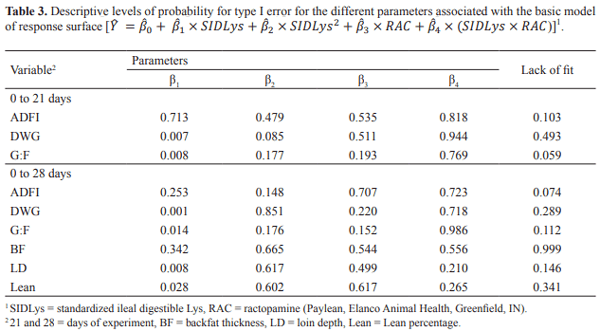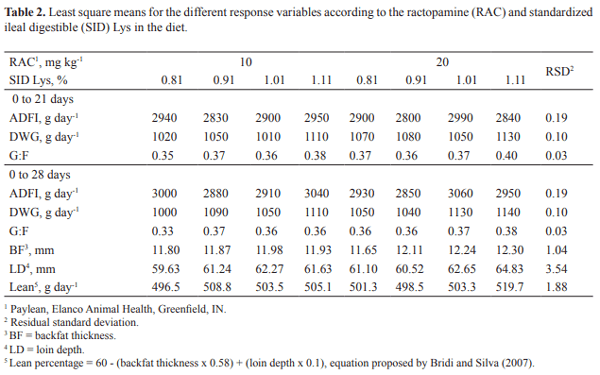Introduction
The β-agonist ractopamine (RAC) is a dietary ingredient used in diets for finishing pigs to redirect nutrients to protein accretion that would otherwise go to the synthesis and deposition of lipids, resulting in improved performance and carcass traits (DUNSHEA et al., 1993; SCHINCKEL et al., 2003). It is well established that Lys requirements for optimal performance and carcass traits are greater for pigs fed RAC (NRC, 2012; ANDRETTA et al., 2012). In addition, the NRC (2012) model suggests that when RAC is included in the diet the requirement for essential amino acids, especially standardized ileal digestible (SID) Lys, increases by 26%.
In a meta-analysis on the relationship between RAC and dietary Lys levels for pigs, Andretta et al. (2012) used a database composed of 29 articles published in peer-reviewed journals; however only one experiment in the data set (WEBSTER et al., 2007) evaluated SID Lys levels in diets for pigs fed RAC. This highlights the importance of studies to estimate the best SID Lys concentration in the diet according to the level of RAC supplementation with the aim of improving the performance and carcass traits of pigs.
It has been suggested that individual housing can be used to determine the growth potential of pigs, but group housing is necessary to assess levels in a commercial situation (WEATHERUP et al., 1998). Nonetheless, previous RAC x SID Lys studies have been conducted with small groups of animals housed in low-density or low-immune-challenge pens (APPLE et al., 2004; WEBSTER et al., 2007) and did not fully represent the situation in commercial pig production. Therefore, the objective of this study was to evaluate the SID Lys requirement of pigs reared in a commercial production system and fed 10 or 20 ppm RAC, based on performance and carcass traits.
Material and Methods
Two consecutive experiments (conducted 2 months apart) were carried out in a commercial production system using 480 pigs each, totaling 960 barrows (Talent × Topigs 40), with an initial BW 71.37 ± 4.86 kg and final BW 101.27 ± 2.87 kg. Experimental procedures were the same for both experiments. For each experiment pigs were allotted in a completely randomized design in a 2 x 4 factorial arrangement, with two RAC levels (10 and 20 mg kg-1) and four SID Lys levels (0.81, 0.91, 1.01, and 1.11%), and six replicates (pens), of 10 pigs each, per treatment. Pigs had free access to feed and water throughout the 28 d experimental period.
Experimental diets (Table 1) were mainly composed of sorghum and soybean meal, and were supplemented with minerals, vitamins, and industrial amino acids to meet all the nutrient requirements, according to Rostagno et al. (2011), except for SID Lys.
Daily feed waste was manually collected and weighed. Pigs were weighed at the beginning of the experiments, at d 21, and at the end of the experimental period in order to calculate ADFI, ADG, and G:F.
At the end of the experimental period (28 d), three pigs per pen were randomly chosen and assessed for loin depth (Longissimus dorsi) and backfat thickness using an Aloka SSD 500 ultrasound. The images were taken between the 10th and 11th ribs as recommended by the National Swine Improvement Federation Guidelines. Subsequently, the images were used to calculate loin depth and backfat thickness using the software Biosoft Swine. The lean percentage was calculated using the equation proposed by Bridi and Silva (2007): Lean percentage = 60 - (backfat thickness × 0.58) + (loin depth × 0.1).
Data were analyzed using the MIXED procedure of SAS 9.4 following a completely randomized design according to a 2 × 4 factorial arrangement (two levels of RAC and four levels of SID Lys). The pen was used as the experimental unit for statistical analysis of ADFI, ADG, and G:F. Three pigs per pen were used as experimental units for statistical analysis of loin depth and backfat thickness. The statistical model included the fixed effects of the RAC levels, SID Lys levels and their interaction, and the random effect of the experiments. After ANOVA, the treatments were compared using a response surface technique. The basic regression model included the linear effect of the RAC level, the linear and quadratic effects of SID Lys levels, and the interaction between the linear effects of RAC and SID Lys levels. The remaining degrees of freedom from treatments were grouped using the LACKOFIT statement of the MIXED procedure to check whether any significant effects other than from treatments had affected the experimental responses. Only the significant effects (α = 0.05) were kept to compose the adjusted models. There was no significant variation between experiments (P>0.05) for any variable evaluated herein. However, the random effect of experiments was taken into account when adjusting the regression models.

Results and Discussion
The least squares means for all response variables according to RAC and SID Lys levels in the diet are presented in Table 2.
There were no effects of either the RAC levels or the interaction between RAC and SID Lys levels on any of the performance and carcass variables (Table 3). No lack of fit was detected in the response surface analysis (Table 3).

There was no effect of SID Lys levels on ADFI on day 21. However, as SID Lys increased, there was a linear increase (P<0.01) in ADG and G:F (Tables 3 and 4). Many of the RAC x SID Lys studies reported in the literature were conducted with small groups of six or fewer pigs per pen and at a low density (APPLE et al., 2004; RIKARDBELL et al., 2013). However, there is now evidence for differences in performance between small-pen university research and studies conducted under commercial production systems (WEATHERUP et al., 1998). The response to RAC supplementation is dependent on dose of RAC, the duration of RAC feeding, and the amount of amino acids in the diet (APPLE et al., 2004; ARMSTRONG et al., 2004). In the present study, there was no effect of the RAC dose or duration (similar responses at d 21 and 28). However, the performance and carcass traits were affected by the SID Lys levels and these levels were above the Brazilian Tables (ROSTAGNO et al., 2011) and NRC (2012) recommendations for pigs fed RAC.

The effects of RAC on performance and carcass traits have been reported previously (SCHINCKEL et al., 2003; APPLE et al., 2004). However, improvements in performance and carcass traits with RAC doses above 10 mg kg-1 are not as clear and are related to the body weight range and duration of RAC feeding. In the present study, the final BW (100 kg) and duration of the trial (28 d) may have limited the effect of the highest dose (20 mg kg-1) of RAC. Crome et al. (1996) compared the growth and carcass traits of finishing pigs in two BW groups (107 and 125 kg final BW) and demonstrated that only the heavier BW group showed a positive response to 10 and 20 mg kg-1 RAC in terms of growth performance and carcass traits. Armstrong et al. (2004) also reported no differences in performance and carcass traits between pigs fed 10 or 20 mg kg-1 RAC for 20 or 27 d, although significant differences were observed on d 34.
The present study and others (APPLE et al., 2004; RIKARD-BELL et al., 2013) showed the lack of effect of SID Lys on pig ADFI. Variations in feed intake as a result of the level of Lys in the diet are associated, among other factors, with the level of energy and the imbalance of amino acids in the diet (DE LA LLATA et al., 2007). In the present study, diets were formulated to contain similar levels of energy, and despite the variation in the SID Lys levels, amino acids were added to maintain the ratio of Lys:amino acids at the level proposed for ideal protein content.
Although there was no effect on ADFI, increasing SID Lys increased the ADG (d 21 and 28) linearly d intake as a result of the level of Lys in the diet SID Lys supplementation up to 1.11%. Our results are consistent with those of Apple et al. (2004), who observed that ADG and feel efficiency improved linearly as SID Lys increased (0.51 to 0.92%) in diets of pigs fed RAC. Webster et al. (2007) reported increasing SID Lys increased the ADG (d 21 and however, further improvements could be observed with up to 1.06% SID Lys supplementation.
The ADG of pigs in the present study was similar to that (1.13 kg d-1) found by Webster et al. (2007) and higher than the best results (0.74 kg d-1) reported by Apple et al. (2004). The lower ADG found by Apple et al. (2004) may be due to the ADFI (2.09 kg d-1) of the pigs. Moreover, our results are consistent with that (1.04 kg d-1) reported by Andretta et al. (2012) in a meta-analysis of the relationship between ractopamine and dietary lysine for pigs. The genetic manual (Topigs Norsvin) estimates the ADG of pigs without RAC as being 0.98 kg d-1.
Loin depth and lean percentage improved linearly (P<0.05) as SID Lys intake increased from d 0 to 28, with no effect on backfat thickness (Tables 3 and 4).
According to Cisneros et al. (1996), the assessment of loin depth and backfat thickness with ultrasound provides accurate measurements of the amount of muscle and fat in the carcass. Thus, no change in backfat thickness associated with a linear increase in loin depth in response to SID Lys levels in the diet is indicative of an improvement in the protein:fat ratio. An increase in lean tissue would be more efficient because the deposition of lean tissue is more energetically efficient than the deposition of adipose tissue (DE LANGE et al., 2001). The verified response pattern for carcass traits in the present study is consistent with the improvement that occurred in G:F, confirming the modification in carcass composition with an improvement in the meat:fat ratio.
Ractopamine is a β-adrenergic agonist used in diets for finishing pigs to redirect nutrients to protein accretion that would otherwise go to the synthesis and deposition of lipids, resulting in improved performance and carcass traits (SCHINCKEL et al., 2003). Thus, the nutrient concentration in the diet must be increased to maximize the RAC response. Accordingly, in the present study, besides the mentioned effects on ADG and G:F, there was a linear increase in loin depth and lean percentage as SID Lys increased from 0.81 to 1.11%.
Although 1.11 % SID Lys resulted in the greatest loin depth and lean percentage, the backfat thickness was not affected by this level of supplementation. Apple et al. (2004) and Webster et al. (2007) reported that pigs fed RAC showed increased loin depth and lean percentage but decreased backfat thickness as Lys increased. As proposed by Armstrong et al. (2004), this discrepancy among studies may be explained, at least in part, by genetic improvements in the modern swine industry. For example, pigs in the current study had an average 10th-rib fat depth measurement of 12 mm (102 kg), whereas the pigs used in the study of Apple et al. (2004) and Webster et al. (2007) had an average 10th-rib fat depth of 17 mm (108 kg) and 18 mm (105 kg), respectively, when fed RAC.
In the present study, 1.11% SID Lys supplementation led to the best performance and carcass traits in pigs fed a diet supplemented with RAC, a level that is above the 0.83% SID Lys currently recommended by the NRC (2012) for finishing pigs (115 to 135 kg) fed RAC. Such differences may be due to the weight range and differences in the environmental conditions in which the studies were performed. Our studies were conducted on a commercial pig farm whereas the nutrient requirements recommended by the NRC (2012) were based on studies conducted with pigs managed in a relatively stress-free environment in terms of temperature, exposure to disease-causing organisms, and space allowance.
Similarly, the Brazilian Tables (ROSTAGNO et al., 2011) recommendation regarding SID Lys for finishing pigs (~107 kg) fed 10 mg kg-1 RAC is 0.86%. Although the Brazilian Tables were only recently published (ROSTAGNO et al., 2011), the experiments that generated the database were conducted some years ago, so changes in the genetic potential of pigs are expected to have occurred. The performance response to dietary Lys can vary with genotype and more recently, after developing a model to describe the growth composition and dietary Lys requirements of pigs fed RAC, Schinckel et al. (2003) predicted an increase in lean percentage associated with lower lipid deposition as dietary SID Lys increased.
According to the present results, it is possible that the SID Lys content of practical diets may limit the performance responses of pigs fed diets containing RAC. When RAC is included in the diet, the requirement for essential amino acids, especially Lys, is increased by about 26 to 30% (NRC, 2012). In our study the amount of SID Lys required for the best performance and carcass traits of pigs fed RAC was as much as 34% more than that recommended in the Brazilian Tables (ROSTAGNO et al., 2011) for pigs in the same phase of growth (70 to 100 kg) fed diets without RAC.
Conclusions
Performance and carcass traits of pigs fed RAC (10 or 20 mg kg-1) in a commercial production system were improved by up to 1.11% SID Lys supplementation. There was no additional benefit of feeding 20 mg RAC kg-1 in comparison with 10 mg RAC kg-1.
Bioethics and Biosecurity Committee Approval
All procedures involving animal handling were conducted in accordance with regulations approved by the Institutional Ethics Committee of Animal Production Use (CEUAP-UFV) of the Universidade Federal de Viçosa, Brazil.
This article was originally published in Semina: Ciências Agrárias, Londrina, v. 38, n. 6, p. 3841-3850, nov./dez. 2017. DOI: 10.5433/1679-0359.2017v38n6p3841. This is an Open Access article licensed under a Creative Commons Attribution License (http://creativecommons.org/licenses/by-nc/4.0/). 











.jpg&w=3840&q=75)